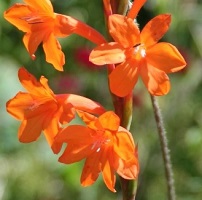
There are 52 species of Watsonia. They
are nearly all from Southern Africa, and are very showy Gladioli-like plants,
first researched by British naturalists in the 18th Century. The genus is named
after the London Botanist Sir William Watson. All Watsonias are perennials,
forming clumps of corms with sword shaped leaves and spikey showy flowers, most
in mid to late summer. Most flower in shades of pink or red, with some
cultivated white forms.
Watsonia plants are either:
- Winter growing plants, originating from the winter rainfall
areas of the Western Cape. The leaves of winter growing plants die down after flowering. The corms need to dry out for a while after flowering, and the plants start growing again in the autumn. Autumn is a good time to plant any bulbs that have been lifted. Species that are not hardy need to be protected over winter when the plants start to grow. Watsonia borbonica is one of the best known of these plants, with stunning pink flowers in midsummer. The red-flowered Watsonia vanderspuyiae also falls into this group. Or,
- Summer growing plants, from the summer rainfall areas of the
north and eastern parts of South Africa. This is a smaller group of summer growing Watsonias. it includes Watsonia lepida from the Drakensberg Mountains and is hardy and well suited to the UK climate. These plants grow during the summer. Corms can be left in the ground over winter, or lifted after flowering and replanted in spring.
Propagation
- By division: New plants can be created by removing the offsets from mature
corms during the dormant period.
- By seed:
Seeds should be sown in
deep trays of well drained seed compost at 3mm deep. Winter growing
species are best germinated at 10-20°C, most commonly in the
autumn, and summer growing species at 15-25°C, most commonly in the
spring. Germination typically takes 3-4 weeks, sometimes a bit longer.
Seedlings should be grown on until the second season to allow a corm to
develop, and then planted out. Flowering starts in the second season with
most species in ideal conditions, sometimes in the third season.
Care
Watsonias grow best in sun and well
drained soil. Flowering reduces if the corms get overcrowded, so it is best to
divide mature clumps every 2-3 years. Watsonias respond well to a slow release
fertilizer. They are not generally troubled by any particular pests or
diseases. Some professional growers spray with an insecticide to prevent aphid
attack and with a fungicide if the weather is warm and wet. |
|